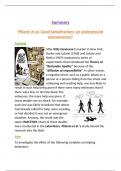Summary
Summary OCR A-Level Psychology: Themes Through Core Studies (H567): Piliavin Summary, Key Points, Flashcards.
- Institution
- OCR
This document includes: - A full DETAILED SUMMARY of the study - The key points of the study - A link to a Quizlet flashcard set, regarding the DETAILED SUMMARY. In the DETAILED SUMMARY: - Context - Aim - Method, Design, Experiment - Conclusion - Evaluations - Linking to The Area and The...
[Show more]



